| |
Shirdi Calendar
The Shirdi Sai Avatar is
extra-ordinary and also enigmatic in many respects. Though this
incarnation belongs to recent history, myth and mystery continue
to surround the story of this Avatar. However, thanks to the
enlightenment provided at various times by Bhagavan Sri Sathya Sai
Baba, one is now in a position to place many of the unknown
aspects of the Shirdi Avatar in a proper perspective.
This calendar offers
a summary of the life and philosophy of Shirdi Baba through a
series of specially commissioned paintings. The summary is wrapped
up with sketches of Shirdi landmarks, as they appeared at various
points of time.
Bhagavan Sri Sathya
Sai Baba has declared that the Shirdi Avatar was the first of a
trilogy of Sai Avatars. The second of course is the current Sathya
Sai Avatar, and the last would be the Prema Sai Avatar. Of the
three, the Shirdi Avatar is the Prologue and the Prema Sai Avatar
is the Epilogue to the Sri Sathya Sai Poorna Avatar. It has
further been revealed that Shirdi Sai was an aspect of Shiva,
Sathya Sai an aspect of both Shiva and Shakthi, while the
yet-to-come Prema Sai would be an aspect of Shakti alone.
|
Bhagavan
Baba has revealed that Shirdi Baba was born in early
nineteenth century to a pious Brahmin couple in the
village of Pathri in the erstwhile Nizam State. The
Divine child was born following a boon granted by Lord
Shiva and Parvathi to the mother, in appreciation of
her deep devotion to God. Shortly before Baba took
birth, the father left home for the forest to lead the
life of a recluse. The lady followed her husband but
could not keep pace, due to the advanced state of her
pregnancy. Finally, she had to halt in order to
deliver the baby. Once the baby was born, she
reluctantly placed it under a tree and went in search
of her husband. Soon there came near that tree a
Muslim couple who picked up the child and brought it
up. In 1842, the adopted father died and the adopted
mother handed over charge of the young boy to one
Gopal Rao, a rural chieftain. Gopal Rao is said to
have placed Baba for some time under the care of a
Guru known as Venkusa. Later Gopal Rao passed away,
and Baba was now on His own. He wandered for some time
and eventually made Shirdi His home. |
|
|
JANUARY 2003 |
 |
|
|
|
It is
said that Baba came to Shirdi when He was about
sixteen years of age. He wore a Kafni, the dress of a
Muslim Fakir. He had no home of His own, and spent
most of His time under a Neem tree that has since
become a pilgrim spot known as Gurusthan. No one knew
who this young man was, where He came from, and where
He got His food. But this much every one knew: This
mysterious young man definitely had a Divine Aura
about Him, and was always most compassionate. Indeed,
throughout His life, Baba's devotees knew very little
about His early history. In the Sai Sat Charita, for
example, one finds the remark: "Nobody knew the
parents, details of the birth or the birth-place of
Sai Baba. Many enquiries were made, many questions
were put to Baba and others regarding these items, but
no satisfactory answer or information has yet been
obtained. Practically, we know nothing about these
matters." Indeed, but for the enlightenment provided
by Bhagavan Sri Sathya Sai Baba, this mystery would
never have been cleared. Divinity often shrouds itself
in mystery, and the mystery is removed only when the
time and the circumstances are appropriate.
|
|
|
FEBRUARY 2003 |
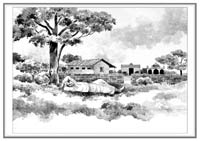 |
|
|
|
There
lived in the village of Dhoop in Aurangabad District
of Nizam State, a Muslim named Chand Patil. He was an
officer of the Nizam State. Once while making a trip
to Aurangabad, Chand Patil lost his mare that he loved
very much. He searched for the mare for two long
months, but could not find it. When returning from the
fruitless search, Patil found a stranger under a tree,
preparing to smoke a Chilim or native pipe. On seeing
Patil go that way, this stranger accosted the tired
merchant, invited him to share a smoke, and rest for a
while. A conversation began and Chand Patil told the
stranger who was none other than Baba, about the loss
of his favourite mare. Baba asked Patil to look in a
ravine nearby. Patil did so, and lo and behold, there
was his lost mare! Amazed, Patil returned to Baba.
Meanwhile, Baba wanted fire to light the Chilim and
some water to wet the pipe, both of which Baba
produced most casually with a miracle. Patil now
believed that Baba was a saint and persuaded Him to go
with him to Dhoop. Some years later, Patil came back
Shirdi to celebrate a marriage in his family, and Baba
returned with Patil. Thereafter Baba never left Shirdi.
|
|
|
MARCH 2003 |
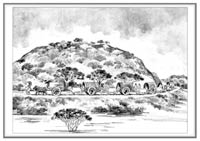 |
|
|
|
When
Baba first came to Shirdi, people there out of
respect, started calling Him Sai. When Chand
Patil's marriage party arrived in Shirdi, the
party alighted in the area near the Khandoba [Shiva]
Temple there. The priest Mhalsapathi, recognised
Baba and welcomed Him with the words Ya Sai,
meaning "Welcome Saint!" When the wedding was over
Chand Patil and his party returned to Dhoop but
Baba settled down in Shirdi, choosing a
dilapidated Mosque as His residence. Later, this
Masjid as it was then known, became the famous
Dwaraka Mai. In due course, Mhalsapathi became a
close companion of Baba. For many years, Baba
slept in the Masjid together with Mhalsapathi and
another devotee named Tatya Kote Patil. They slept
with their heads pointing towards the East, West
and the North but feet touching together! If Tatya
snored, as he did sometimes, Baba along with
Mhalsapathi would turn Tatya over, rub his back
and press his legs! Devotees wanting to worship
Baba would offer sandal paste but no one dared to
directly apply it on Baba. Mhalsapathi alone had
the privilege of applying the paste on Baba's
throat. Blessed are they who earn Divine intimacy.
|
|
|
APRIL 2003 |
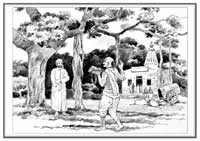 |
|
|
|
|
According to the scriptures, a Brahmachari and a
Sannyasi have to live by begging. Both the
Brahmachari and the Sannyasi are supposed to
regard the whole Universe as their home, and all
humans as belonging to the world-family. Baba
resorted to seeking alms, perhaps to make His
devotees see humanity as one large family. Every
day Baba would go out with a tumbler in His hand
and a Jholi or a bag strung round His shoulder, to
just a few houses. In the tumbler He received
cooked items and liquids, while in the Jholi He
collected Bhakri or millet bread. He was content
with what He received, and did not have any sense
of taste - He was above the senses. The food
collected would be put into wide-mouth earthern
jar in the Masjid, from which even cows and crows
were free to draw! The lady who swept the Masjid
also took some Prasadam to her home. In the
beginning, Baba did notfollow this practice. He
would just disappear into the forest and there,
Bayjabai, a woman of great devotion would go out
everyday seeking Baba, and offer some Bhakri to
Him. Later Baba stopped going to the forest, and
that was when He began seeking alms. |
|
|
MAY 2003 |
 |
|
|
|
|
Once
there was a theft in the village, and the accused
claimed in court that Baba had given him the
stolen property. The Magistrate then issued a
summons to Baba, asking Him to appear in Court and
give evidence. When the summons was served, Baba
threw it into the fire! The devotees were alarmed
by this and afraid of the consequences. They
therefore approached the Magistrate and explained
that since Baba was a holy person, the issue of a
summons was inappropriate. Instead, the Court
could send an Officer to collect the required
evidence. Accordingly, a Commissioner was sent to
interview Baba. The Police Officer went to the
Masjid and discovered that he was no match for
Baba. For example, when asked His age, Baba
replied, "Hundreds of thousands of years." When
asked if He knew the accused, Baba replied that He
knew everyone! When asked if He gave the jewels
and if so, how they came into His possession, Baba
replied, "Everything belongs to Me!" The Officer
tried to remind Baba that this was an
investigation by saying, "Here is a serious charge
of theft ?." Baba cut the Officer short with the
words, "What have I got to do with all this
nonsense?" The conversation ended there and the
Officer withdrew, having drawn a complete blank! |
|
|
JUNE 2003 |
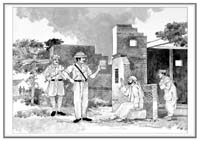 |
|
|
|
|
Baba
was very fond of lighting lamps in the Masjid. In
the early days, the oil for the lamps was offered
free by the shop-keepers as a token of love, and
Baba would go personally, tumbler in hand, and
receive the oil from the merchants. He would then
pour this oil into earthern lamps, using pieces of
old cloth as wick. On the festival day of
Deepavali, there would be extra lamps to celebrate
the occasion. After some time, the grocers became
tired of giving oil free to Baba and demanded
payment. They obviously did not appreciate who
Baba really was. Baba, naturally, was not going to
pay, and He silently returned to the Masjid. In
full view of the grocers, Baba first shook off the
traces of oil in His tumbler, filled it with
water, yes water, and then poured this water into
the lamps, ready with wicks. Thereafter He lit the
lamps, and wonder of wonders, the lamps all
started burning; not only that, they kept burning
all night. The shop-keepers realised their mistake,
fell at Baba's feet and sought pardon. They at
last understood that Baba was Divine. |
|
|
JULY 2003 |
 |
|
|
|
|
Baba
taught lessons in the most unusual manner.
Lakshmibai Shinde was an ardent devotee of Baba.
Once, she made a nice dish for offering to Him.
After that she left the kitchen for a short while,
to attend to some work. Meanwhile a dog gained
entry into the kitchen and helped itself to the
tasty item. Seeing this, Lakshmibai angrily dealt
a few blows to the dog with a stick. Cursing the
dog, the lady made the dish afresh, took it to
Baba and offered it to Him. Baba refused to accept,
though He was known to like this dish very much.
Puzzled, Lakshmibai asked Baba why He refused, and
He replied that it was because she had chased Him
away when He came to her house. Lakshmibai was
astonished because Baba had not come to her house,
and who would dream of chasing Him away? So she
protested, whereupon Baba said: "I don't have to
come in this particular form. I can come in any
form. I came as a dog and what did you do? Did you
not rain blows on Me?" Swami says that in this
way, Shirdi Baba taught that He is Omnipresent,
and that all forms are His. |
|
|
AUGUST 2003 |
 |
|
|
|
|
To
Das Ganu, a devotee of Baba, belongs the credit of
popularising the name of Baba among the masses. In
1897, Baba started the celebration of the Rama
Navami festival in Shirdi. In 1912, it was decided
to include a Harikatha or a musical rendering of
the story of the Lord, as a part of the annual
celebration. In 1914, Baba entrusted the job to
Das Ganu, who took this job most seriously. In
fact, he went to various places singing the glory
of Baba. Once, Das Ganu was grappling with the
intricacies of the scriptures, and unable to find
answers to his doubts, he sought Baba's guidance.
Baba told him, "Go to Kaka Dikshit's house in Vile
Parle (a suburb of Bombay). Kaka's maidservant
will clear all your doubts". On the face of it,
this is an extra-ordinary directive; yet, such was
Das Ganu's faith in Baba that he did exactly as
commanded. In Kaka Dikshit's house, Das Ganu saw
that the servant, a young girl, was busy in her
work but happily singing as if she did not have a
care in the world. Das Ganu learnt then and there
that contentment is the most precious gift one can
ever get. |
|
|
SEPTEMBER 2003 |
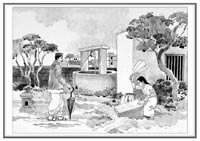 |
|
|
|
|
As
Bhagavan Sri Sathya Sai Baba often reminds us, the
main purpose of the Sai Avatar is to draw the
attention of mankind to the Divine Oneness that
permeates Creation. The ancients knew this Truth
but then, mankind also tends to quickly forget the
Truth. And that is why, from time to time, the
Lord has to incarnate, as Krishna explained to
Arjuna. In the Shirdi Avatar, the Lord adopted a
very novel strategy to promote the Spirit of
Oneness. Baba conducted Himself in such a way that
the Muslims thought He was a Muslim while the
Hindus believed He was a Hindu. In the process,
Baba drew both communities to Him. Thus, in 1897,
Gopalrao Gund, got the idea of celebrating the
Muslim festival of Urs. Together with other Hindu
devotees like Tatya Patil and Madhav Rao Shinde (Shyama),
Gund got Baba's approval to celebrate the
festival. Thereafter, the annual celebration of
the Urs festival became a routine affair.
Interestingly, it was celebrated on Rama Navami
day, and naturally, it was the Muslims who took
the leading part. From 1912, the Urs was combined
with Rama Navami celebrations. In this manner, in
many different ways, Baba drew not only Hindus and
Muslims to Him, but also the Parsis, and even the
English, who then ruled India. |
|
|
OCTOBER 2003 |
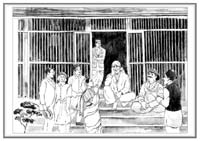 |
|
|
|
|
In
the beginning, the Masjid was Baba's residence.
Later, He adopted one more location, the Chavadi.
In fact, one night He slept in the Masjid, and the
next night He spent in the Chavadi. This
alternation went on till the very end. From 1909,
devotees began to offer regular worship to Baba in
the Chavadi. The distance between the Masjid and
the Chavadi was small; yet, Baba's journey from
one residence to the other was quite an event. The
book Sai Sat Charita describes in great detail
Baba going in procession from the Masjid to the
Chavadi. Baba would walk accompanied by Tatya
Patil and Mhalsapathi. While Patil walked on the
right holding a lantern, Mhalsapathi on the left
would be holding the hem of Baba's garment. Nana
Nimonkar held the umbrella. In the procession
would be Bhajan singers, and the crowd would raise
the name of the Lord. There was a spot before the
Chavadi, where Baba stood for a long time giving
Darshan, His face glowing with extra-ordinary
lustre. On reaching the Chavadi, Aarathi would be
offered. The painting above is based on a famous
photo taken during one of Baba's movement from one
residence to the other. |
|
|
NOVEMBER 2003 |
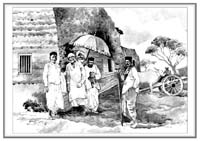 |
|
|
|
|
Lakshmibai Shinde she was one of the very few
ladies who was privileged to serve Baba. To
Lakshmibai fell the honour of bringing food [Bhakri
and milk] daily to Baba, at the appointed time.
Others too would send food, but Baba would not
touch any of it till Lakshmibai's offering came;
He would patiently wait till then; such was His
Love for Lakshmibai. When the end drew near, Baba
called Lakshmibai to His side and affectionately
gave her nine rupees. Lakshmibai was quite well to
do. Why then did Baba give her money, and what was
the significance? Lakshmibai did not understand
but faithfully treasured the nine coins till the
end of her life and never gave them away. Our
beloved Swami has explained that Shirdi Baba gave
Lakshmibai nine rupees to remind her that there
are nine paths to reach God, the Navarasa Bhakti
Marga of the scriptures. As Swami often recalls,
these are Sravanam [listening to His Glory],
Keertanam [singing His Glory], Vishnu Smaranam [chanting
His Name], Pada Sevanam [service to the Lotus Feet],
Archanam [ritual worship], Vandanam [offering
salutations], Dasyam [being the servant of the
Lord], Sakhyam [being the friend of the Lord], and
Atma Nivedanam [surrendering to the Lord].
|
|
|
DECEMBER 2003 |
 |
|
|
|
Source:
Radio Sai
E-Magazine, 1st October 2003
http://www.radiosai.org/Journals/03OCT01/Shirdi_Story/Shirdi.htm |
